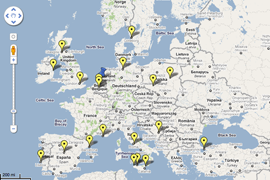It’s going to be the showpiece of Hamburg: HafenCity. A city development project that’s to expend the city centre by 40 percent. At the moment the area at the riverbank of the Elbe is one big building pit. But by 2025 HafenCity will be a new city district that shows why Hamburg is an international metropolis. To achieve this goal culture is playing an important role. The creative industry is used to make HafenCity attractive. But how attractive is HafenCity for creatives?
The HafenCity-project
South of the city centre the old port quarters at the Elbe River are built up with offices, hotels, shops, official buildings and residential areas. The new district is just underneath the historical warehouse district Speicherstadt. UNESCO enlisted these impressive timber-pile founded red brick warehouses from the end of the 19th century as World Heritage sites.
But when one crosses a bridge from Speicherstadt to HafenCity leaves history behind and steps into a forest of modern architecture. High rise apartments, curvy balconies, asymmetrical steps and streamlined facades dominate the décor of Hamburg’s new city development project. The project started in 2000, covers a total of 157 hectares and is to be finished in 2025. So far about 60% of the project is either finished or under construction.
“I don’t like the whole look of HafenCity. It looks like modern Legoland with little atmosphere. I would feel like a robot or something living there,” says Marion, an artist living in Hamburg. Mostly she makes sculptures, but she also paints and photographs. She does what she wants and that’s why she describes herself as a free artist.
In line with Richard Florida’s social and economic theories on the ‘creative city,’ the creative class must play an important role in making HafenCity a lively, diverse and attractive neighbourhood. Something must be done to make it feel less like a Legoland and more like a booming place to be in order to attract creative people.
Attracting culture
“It’s crucial for the city to attract artists, musicians, designers, cultural events and such to make HafenCity a successful neighbourhood,” explains Kai-Michael Hartig of Körber-Stiftung. The Körber-Stiftung is one of the foundations that take part in the cooperation ‘Kunst und Kultur in der HafenCity’ (Art and Culture in HafenCity). The task of this cooperation is to initiate and support cultural events in HafenCity. According to Hartig the idea behind the cooperation is that: “Culture connects people and adds an lively atmosphere to the district, which makes it more attractive.”
Besides cultural landmarks such as the International Maritime Museum, the Science Center with Science Theater and the Elbphilharmonic Concert Hall, HafenCity is supposed to offer space to a variety of cultural initiatives.
So far there have been several projects. There’s a large stone mosaic-like eastern carpet ‘rolled out’ to welcome people to HafenCity. Several readings and performances have been held on the Magellan Terrassen. Also it was the building site of the stage of the Subvision Art Festival in 2009.
This year Christian von Borries performed a modern musical piece called ‘Global Design’ in the belly of a cargo ship. Together with young musicians and scientists he created a combination of digital and live music. Dirk Paschke and Daniel Milohnic are creating a social sculpture that’s going to bring people together this summer. They’re making a swimming pool out of port containers.
Oberhafen
A closer look at these projects shows that HafenCity inspires many artists, but mainly artists from abroad. The Hamburg artists themselves seem to stay away. It doesn’t look like the creative class is settling into HafenCity yet. “The fact that foreign artists are inspired by HafenCity and come here to show their work, fits perfectly in the image of Hamburg becoming more and more an international metropolis. But to make sure HafenCity is also attractive for Hamburg’s own artists, there’s the project Oberhafen. A separate area in HafenCity reserved for the creative class where they can live and work,” says Hartig.
At the southeast end of HafenCity, Oberhafen is an area that initially was destined for industrial purposes. Now the plan is to make it a dynamic creative and cultural quarter. With affordable low-budget apartments Oberhafen must attract Hamburg’s creatives.
The artist’s view
Oberhafen seems to be the cities answer to the protests of the ‘Recht auf Stadt’-network (‘Right to City’). Students, artists, designers and journalists, who strive for more social rights to make the city liveable for low-income households, formed this network in 2009. They wrote a manifest called ‘Not In Our Name, Marke Hamburg’ in which they express their dissatisfaction with the process of gentrification in Hamburg.
To enforce their words they occupied some old warehouses in the neighbourhood Gängeviertel in the north of Hamburg’s city centre. Free-artist Marion and her painter colleague Florian still live in Gängeviertel and explain their actions in a little café around the corner of their ateliers.
“Several areas where the rents were cheap and we could work freely in a nice atmosphere were cleaned up by the city,” says Florian. “The little cafés and shops were changed for shopping malls and big chain companies such as Starbucks. Streets and buildings were renovated and prices went up. We couldn’t afford that so were forced to move.”
As a reference to Gängeviertel the development in Oberhafen will be based on old warehouses. But that still won’t attract Marion or Florian. For Marion it would still feel like a straightforward modern Legoland-like district. Florian puts it differently: “It feels that everything is forced to fit the perfect picture. You can’t force culture to move to a set place. Where’s the room for spontaneity?”
